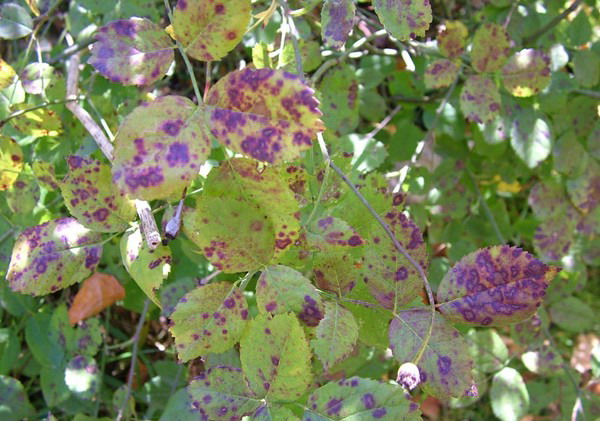 The appearance of ugly spots on the leaves is capable of overshadowing the charm of flowering rose bushes. Spots can have brown, white, yellow, red or rusty color, and in all cases indicate problems with the plant's health.
The appearance of ugly spots on the leaves is capable of overshadowing the charm of flowering rose bushes. Spots can have brown, white, yellow, red or rusty color, and in all cases indicate problems with the plant's health.
Black spotting is a fungal disease, the symptoms of which most often appear in the summer, not only significantly reduces the decorativeness of the bushes, but can also interrupt the flowering of roses.
Content
Causes of black spots
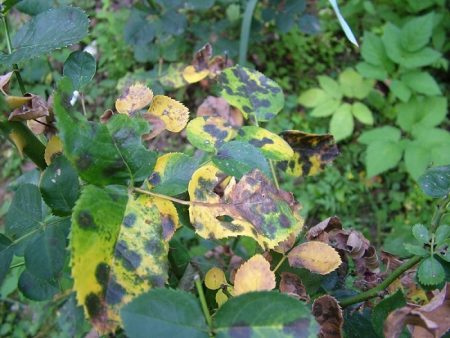 Black spotting in roses is caused by the fungus Marssonina rosae. The pathogen is distributed by spores and activated in conditions of high humidity in warm weather. The most favorable time for the development of the fungus is spring. The disease rarely appears in dry and hot summers.
Black spotting in roses is caused by the fungus Marssonina rosae. The pathogen is distributed by spores and activated in conditions of high humidity in warm weather. The most favorable time for the development of the fungus is spring. The disease rarely appears in dry and hot summers.
Shrubs growing in lowlands or surrounded by dense thickets of plants in the flower garden are primarily affected by diseases, since these factors impede the normal evaporation of moisture after rainfall and irrigation. The development of fungi is also promoted by: a lack of lighting or nutrients in roses, in particular potassium deficiency, an excess of nitrogen, and heavy and acidic soils are critical.
Symptoms and course of the disease
The disease does not manifest itself immediately, the first signs of damage appear a month after the active development of the fungus. The exception is warm and humid summers, at a temperature of about 30 ° C the disease becomes noticeable after 10 days. On average, black spotting on rose bushes is most likely to be detected by mid-summer.
The lesion spreads from the bottom to the top of the bush. Dark brown spots appear on the leaves and shoots, framed by a yellow border. As the disease progresses, other symptoms occur:
- spots acquire a black color and increase in size;
- twisting and yellowing of the leaves is observed;
- falling of deciduous cover from bushes;
- slowing and stopping the growth of shoots;
- poor flower formation, up to the cessation of flowering.
Spores of the fungus hibernate safely in the ground, which makes the reappearance of the disease in the next season likely.
Black Spot Treatment
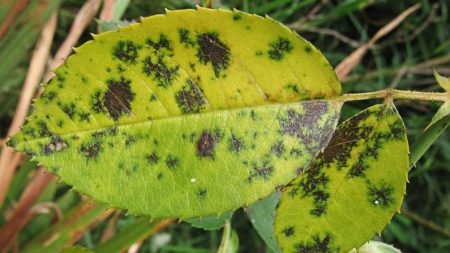 The fight against black spotting comes down to pruning the affected parts from the bush, treating the plants with antifungal agents and preventive methods that also inhibit the development of the fungus.
The fight against black spotting comes down to pruning the affected parts from the bush, treating the plants with antifungal agents and preventive methods that also inhibit the development of the fungus.
Timely spraying of roses with folk remedies, as a rule, give a positive result, while in the later stages of the disease it is recommended to use chemical fungicides. It is worth considering that after the appearance of the first symptoms, the disease begins to develop very quickly.
The most powerful folk remedies:
- Bordeaux fluid. In different buckets, copper sulfate and lime are diluted with a small volume of water, while the volume of the first substance should be 2 times less than the second. Copper sulfate is diluted with hot water, and lime - cold. Both solutions are thoroughly mixed and added to each cold water, so that in both buckets an equal volume of liquid is obtained. After mixing, the solution of copper sulfate is poured into a container with a solution of lime and mixed again. The amount of water is determined by the required concentration of the solution.For spraying rose bushes from black spotting, a 1% solution is usually used. That is, for 10 liters of water, you should take 100 g of vitriol, 200 g of lime and make both solutions of 5 liters. Treatment with Bordeaux fluid should be performed 2-3 times, taking between weekly or ten-day breaks between sprayings.
- Colloidal sulfur. It is necessary to dilute in a bucket of water 30 g of sulfur. The solution is sprayed with rose bushes three times with intervals of 10 days.
- Horsetail decoction. To prepare the product, you can use fresh or dried raw materials, in the first case a bucket of water will require 1 kg, in the second - 150 g. Horsetail should be infused for 24 hours, then the infusion must be boiled for half an hour. After cooling, the liquid is filtered and diluted with each part of the infusion of 10 parts of pure water.
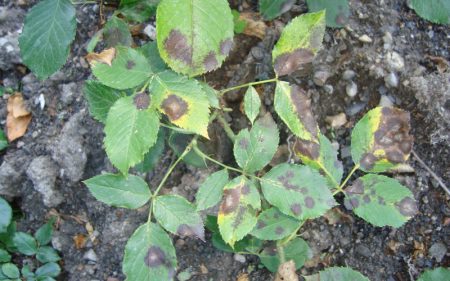
- Nettle infusion. Leaves, stems and roots (but without flowers and seeds) of fresh nettle are poured into a bucket to half and poured boiling water in a bucket. Insist means should be from 2 days, stirring from time to time to enhance fermentation processes.
- Liquid manure. It is recommended to use rotted cow manure. One part is poured with 2 parts of water and left for 3 days. After that, the infusion is filtered and diluted with twice a large volume of water. Processing is carried out every 2 weeks 3 times.
- Infusion of dandelion. 1 kg of roots and green parts of the plant is crushed and poured with 10 liters of water. After a day, the product must be filtered and can be used for spraying and watering the bushes (to destroy spores of fungi that have taken refuge in the ground). 3 treatments are carried out with interruptions of 7 days.
- Onion husk tincture. Take 100 g of onion husks and pour half a bucket of cold water. After 24 hours, the infusion is required to strain and dissolve 5 g of soap in it. Spray roses with the product once every 10 days three times.
- Ash. Wood ash against black spotting is used in dry form for dusting bushes.
In autumn, when pruning the bushes, the affected shoots, regardless of the degree of damage, should be cut to the level of the second or third kidney.
Prevention
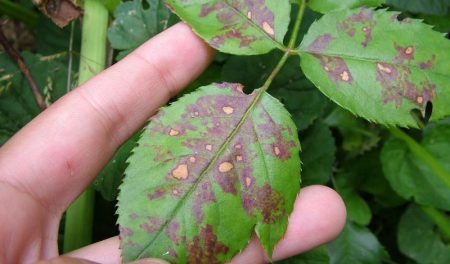 Prevention of black spotting include:
Prevention of black spotting include:
- providing roses with suitable conditions for growth;
- compliance with annual sanitary measures;
- preventive treatment in case of risk of the disease.
Growing conditions
Prevention of black spotting in roses begins with choosing a place for planting bushes and planning a flower garden.
Culture requires:
- The sun. For roses, sunny places should be allotted where plants can receive enough light during the day. It will also benefit the flowering and general condition of the bushes.
- Slightly acidic soil. When planting on soils with high acidity, it is necessary to carry out the liming procedure - add 250-500 g of dolomite flour or 150-250 g of lime.
- Space. Keeping the distance between the bushes prevents the rapid spread of the disease. Also, do not surround the bushes with a dense wall of other plants - the fungus often appears where there are obstacles to free air circulation.
- Good food. Roses must be fed during the growing season, during and after flowering. It is necessary to provide plants with phosphorus, potassium, not to forget about fertilizing with micronutrient fertilizers, but to show reasonable moderation in nitrogen nutrition.
- "Crop rotation". It is advisable not to plant bushes in places where roses have already grown. Planting can be done only 5 years after growing other crops on this site.
Planting hygiene
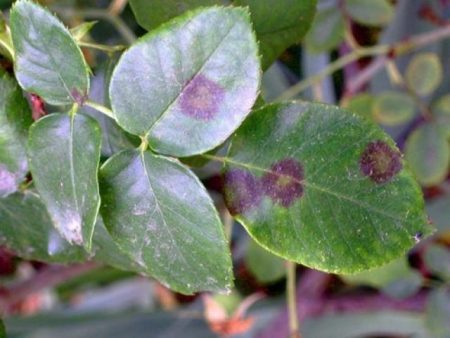 In the spring and autumn, it is necessary to carry out a number of sanitary measures aimed at reducing the risks of diseases in roses.
In the spring and autumn, it is necessary to carry out a number of sanitary measures aimed at reducing the risks of diseases in roses.
- Removing dry and damaged branches is recommended to be performed twice a year - when preparing the bushes for wintering and after releasing the roses from the shelters in the spring. If necessary, thinning crown pruning should also be done.
- In autumn, before placing roses under shelter, you need to clean the bushes from the remaining deciduous cover.
- Since the spores of many fungi, including the pathogen of black spotting, winter in the soil, on the eve of the shelter of the bushes and immediately after removing the protection in spring, the soil under roses should be treated with 0.01% solution of copper sulfate. It is recommended to alternate this tool with a solution of iron sulfate.
- In the autumn, bushes can also be treated with Bordeaux liquid or copper sulfate solution at a concentration of 3%.
- In the spring, it is worthwhile to spray the roses once with the preparations “Skor”, “Profit”, “Ridomil Gold” or “Strobi” during the appearance of the leaves. An alternative to this can be two sprayings with biological agents, for example, the Fitosporin-M preparation, performed with a weekly break.
- Throughout the season, weeds that thicken the planting must be removed from the flower garden.
Next to roses, it is recommended to plant garlic, from ornamental plants - lavender, sage, calendula. The fungus does not like these crops, so the appearance of black spots on the leaves of roses growing in such an environment is unlikely.
Bushes processing
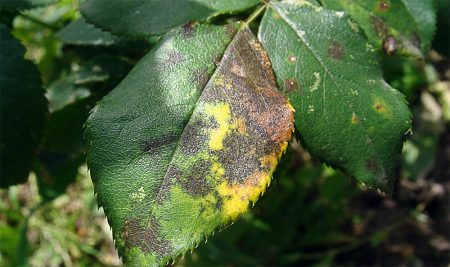 If spring or summer turned out to be rainy and warm, you should be safe, taking additional measures against fungal diseases. It is recommended to conduct regular weekly treatments throughout the season:
If spring or summer turned out to be rainy and warm, you should be safe, taking additional measures against fungal diseases. It is recommended to conduct regular weekly treatments throughout the season:
- The infusion of tobacco. A bucket of water requires 500 g of dried and finely chopped tobacco leaves. Raw materials are poured with boiling water and left for 5 days. Before use, the infusion must be filtered.
- Garlic infusion. Take 200 g of chopped heads of garlic and pour a liter of warm water. After 5 days of insisting, the solution is filtered and 1/2 cup is added to a bucket of water.
- Wood ash. Directly during the rainy season, the ash should be scattered in the near-stem circle of rose bushes.
Resistant varieties
The least resistance to black spotting is shown by varieties of groups such as tea, polyanthus and climbing roses. Planting should be avoided if conditions favor the appearance of the fungus. And the most resistant to damage by spotting are varieties of roses with glossy leaves - their dense peel “too tough” to the fungus.
Among the most resistant varieties can be noted:
- "Grande Amore";
- Baronesse
- Quadra
- La Perla
- Leonardo de Vinci
- Memoire
- Sebastian Kneipp
- Nostalgie
- "Resonanz".
The most important thing in the fight against black spotting is to provide roses with quality care, since the fungus primarily attacks weak and depleted plants. If for some reason roses are at risk, it is necessary, without waiting for the appearance of diseases, to take measures to restore their resistance to adverse factors. To do this, they introduce a special feeding regimen (enhanced potassium nutrition), water the bushes with growth stimulants and use drugs to strengthen the immunity of roses.

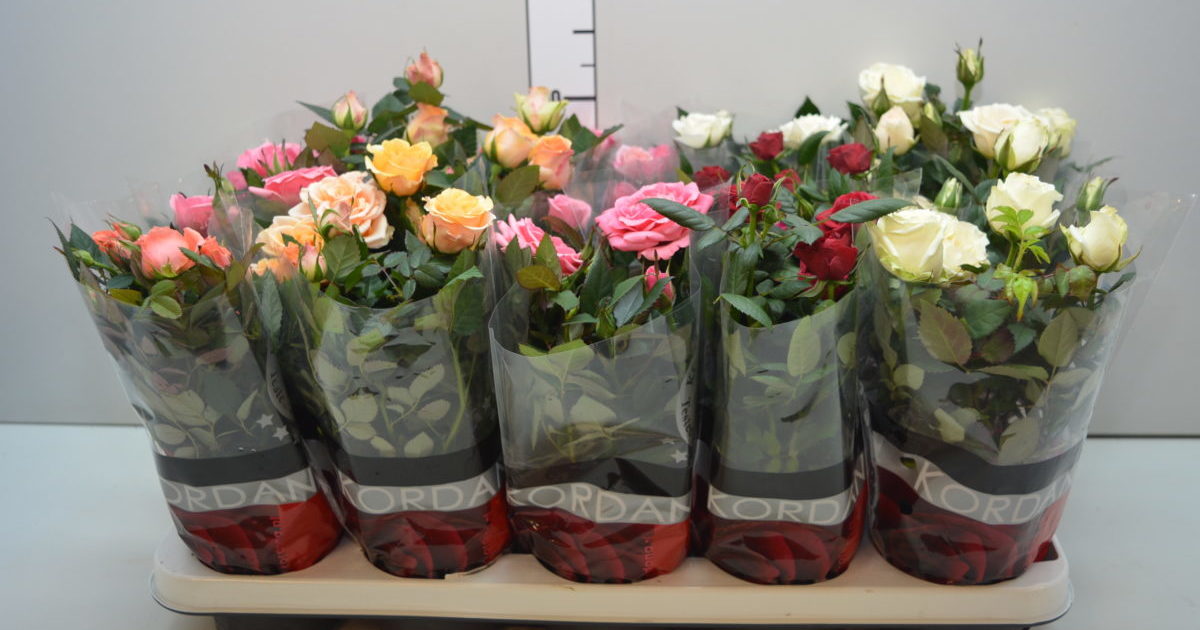
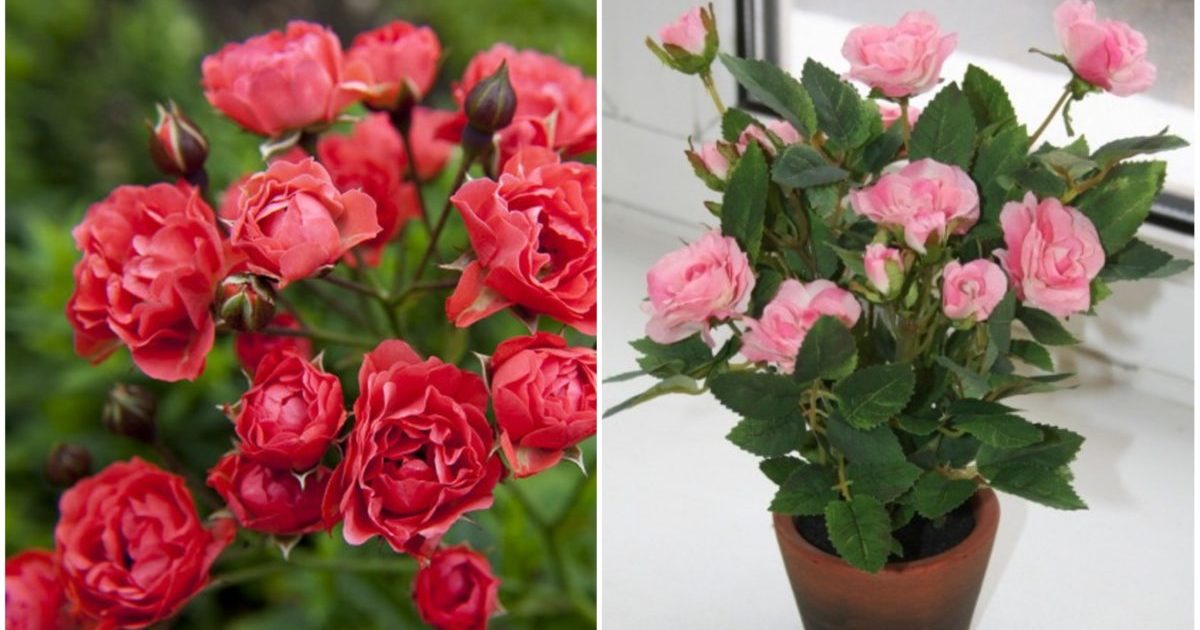
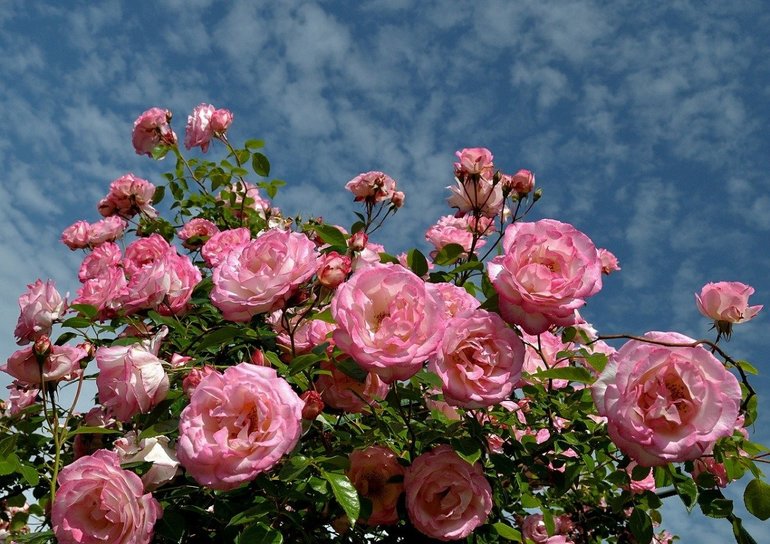
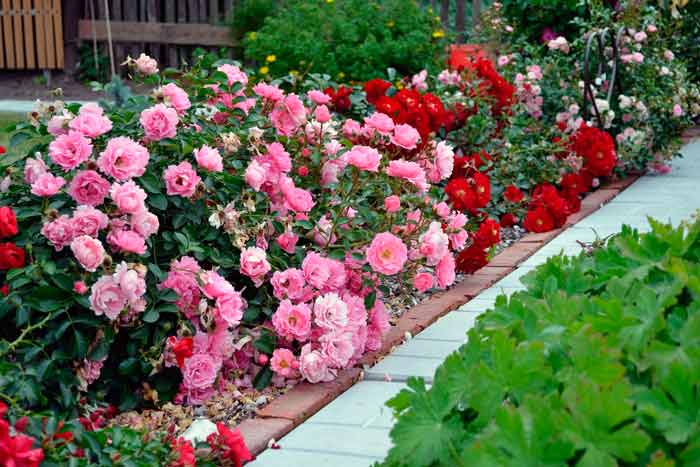 Shelter of roses for the winter: at what temperature does the robot hold
Shelter of roses for the winter: at what temperature does the robot hold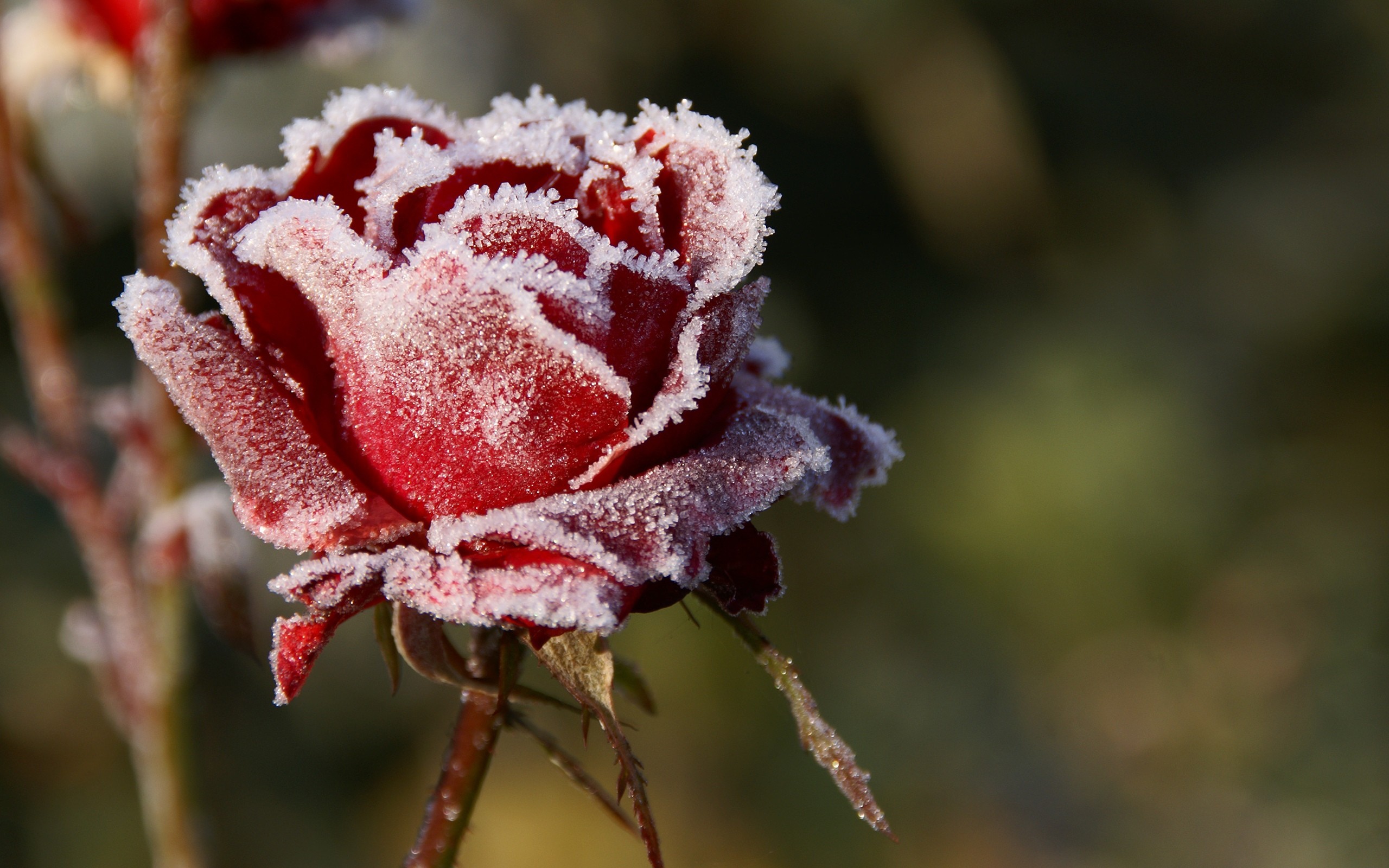 How to prune roses in the fall: timing, pruning rules, pros and cons
How to prune roses in the fall: timing, pruning rules, pros and cons What are the varieties and types of roses
What are the varieties and types of roses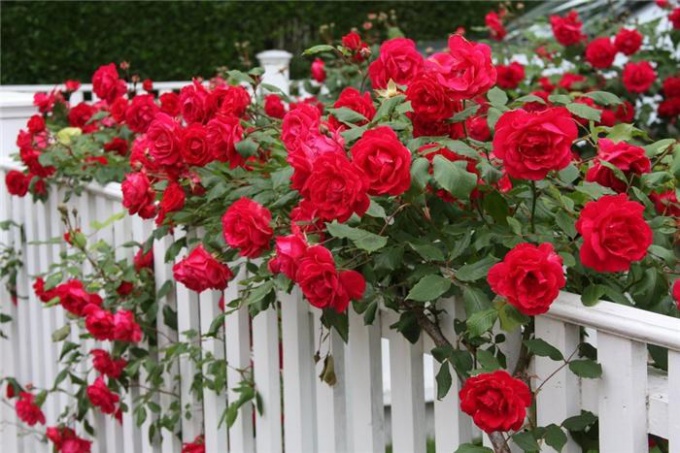 How to treat roses with iron sulfate in autumn: proportions, advantages and disadvantages
How to treat roses with iron sulfate in autumn: proportions, advantages and disadvantages